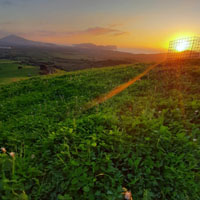How does soil carbon sequestration affect greenhouse gas emissions from a sheep farming system? Results of a life cycle assessment case study

Accepted: 8 April 2021
HTML: 31
All claims expressed in this article are solely those of the authors and do not necessarily represent those of their affiliated organizations, or those of the publisher, the editors and the reviewers. Any product that may be evaluated in this article or claim that may be made by its manufacturer is not guaranteed or endorsed by the publisher.
A life cycle assessment (LCA) study of a transition from semiintensive to semi-extensive Mediterranean dairy sheep farm suggests that the latter has a strong potential for offsetting greenhouse gas (GHG) emissions through the soil C sequestration (Cseq) in permanent grasslands. The extensification process shows clear environmental advantage when emission intensity is referred to the area-based functional unit (FU). Several LCA studies reported that extensive livestock systems have greater GHG emissions per mass of product than intensive one, due to their lower productivity. However, these studies did not account for soil Cseq of temporary and permanent grasslands, that have a strong potential to partly mitigate the GHG balance of ruminant production systems. Our LCA study was carried out considering the transition from a semiintensive (SI) towards a semi-extensive (SE) production system, adopted in a dairy sheep farm located in North-Western Sardinia (Italy). Impact scope included enteric methane emissions, feed production, on-farm energy use and transportation, infrastructures as well as the potential C sink from soil Cseq compared to emission intensity. In order to provide a more comprehensive analysis, we used the following FUs: 1 kg of fat and protein corrected milk (FPCM) and 1 ha of utilised agricultural area (UAA). We observed that the extensification of production system determined contrasting environmental effects when using different FUs accounting for soil Cseq. When soil Cseq in emission intensity estimate was included, we observed slightly lower values of GHG emissions per kg of FPCM in the SI production system (from 3.37 to 3.12 kg CO2 equivalents – CO2-eq), whereas a greater variation we observed in the SE one (from 3.54 to 2.90 kg CO2-eq). Considering 1 ha of UAA as FU and including the soil Cseq, the emission intensity in SI moved from 6257 to 5793 kg CO2-eq, whereas values varied from 4020 to 3299 kg CO2-eq in SE. These results indicated that the emission intensity from semi-extensive Mediterranean dairy sheep farms can be considerably reduced through the soil Cseq, although its measurement is influenced by the models used in the estimation.
Highlights
- Extensification of dairy sheep systems provides an environmental benefit when soil C sequestration is considered.
- Extensification of dairy sheep systems determines lower environmental impact per hectare of utilized agricultural area.
- Enteric methane emissions are the main source of GHG emissions of the sheep milk life cycle.
- Carbon sequestration in permanent grasslands can considerably contribute to climate change mitigation.
How to Cite

This work is licensed under a Creative Commons Attribution-NonCommercial 4.0 International License.
PAGEPress has chosen to apply the Creative Commons Attribution NonCommercial 4.0 International License (CC BY-NC 4.0) to all manuscripts to be published.

 https://doi.org/10.4081/ija.2021.1789
https://doi.org/10.4081/ija.2021.1789







